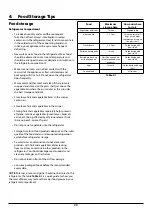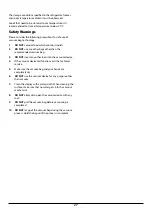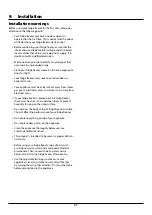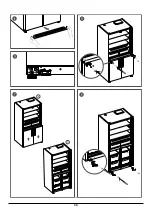
21
Tips on Storing Fresh Food
• Make sure that foods, which have been cooked and
require chilling, are at room temperature before placing
them into the appliance. Make sure that these foods are
stored in suitable containers.
• Foods stored in the refrigerator should be cleaned and
dried before storing.
• Before foods are put into the refrigerator, it is
recommended that the foods should be pressurised,
so that the water cannot vaporise, and the fruits and
vegetables keep fresh and food smells will not mix.
• Stored foods can be marked in bags.
• Foods eaten daily should be stored at the front of the
shelf.
• Make sure that foodstuffs are stored systematically (raw
meats with raw meats, dairy with dairy) to avoid flavour
transfer and cross contamination. Raw meats should be
stored towards the bottom of the appliance to prevent
the possibility of it dripping onto uncooked food. Other
foods should be stored above raw meat.
• When storing food in the fresh food section always
make sure there is adequate space for airflow
circulation. This helps to maintain the shelf life of the
food.
• When storing food in the refrigerator make sure that
foods are not too close to the rear wall to avoid the risk
of freezing.
• It is suggested for radishes and other root vegetables to
trim the leaves. This keeps the nutrition in the root and
not absorbed by the leaves.
• Put frozen foods into the fresh food area to let them
defrost. The low temperature of the refrigerator reduces
the formation of bacteria and extends food life.
• Some foods like onions, garlic, bananas and root
vegetables are better stored at room temperature than
in the fridge.
• Melon, pineapples and bananas can go directly into the
freezer after preparing, for storage over a longer period.
• Packaging fresh foods properly, using the correct
temperature and taking into account food hygiene, will
enhance the quality of fresh foods stored within this
appliance.
• Use plastic bags, aluminium foil or other food wraps to
cover fresh foods not in packaging to prevent flavour
transfer and prevent contamination.
• Before storing items in multi-packs (i.e. yoghurt) remove
any excess packaging.
• NEVER store anything that is flammable, volatile or
explosive inside the appliance.
• Beverages with high alcohol content should be stored
vertically in tightly sealed bottles.
• Delicate foods should be stored in the coolest part of
the appliance.
• Try not to open the door too often.
• Set the thermostat to make sure that foods remain
suitably cold; try to avoid freezing within the fridge.
Using a thermometer will help you to judge how cool
the appliance is. Place it into a glass of water and leave
it inside the appliance for several hours to get a reliable
reading.
• Some foods contain natural oils and acids (e.g. citric
acid) which can damage plastics if spilled – make sure
these foods are suitably contained.
• Unpleasant odours inside the fridge are a sign that
something has spilled and cleaning is required. Using
warm water with bicarbonate of soda will clean the
interior of the appliance and remove most spillages (see
‘Cleaning and Maintenance’).
• Always remember to remove perishable foods from this
appliance before taking prolonged trips of holidays.
Summary of Contents for Deluxe RSXS19
Page 34: ...32 Door removal and access...
Page 35: ...33...
Page 36: ...34...
Page 37: ...35...
Page 38: ...36...
Page 39: ...37...
Page 44: ...42 11 Circuit Diagram...
















































